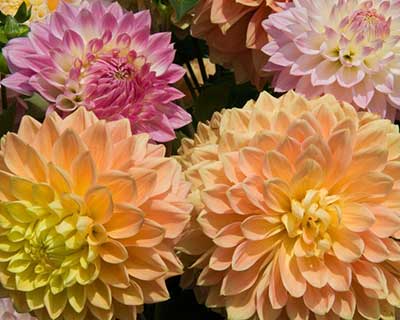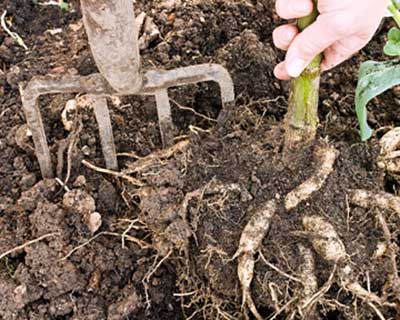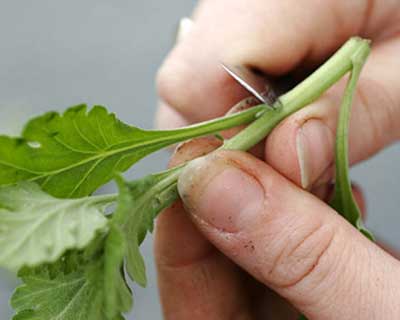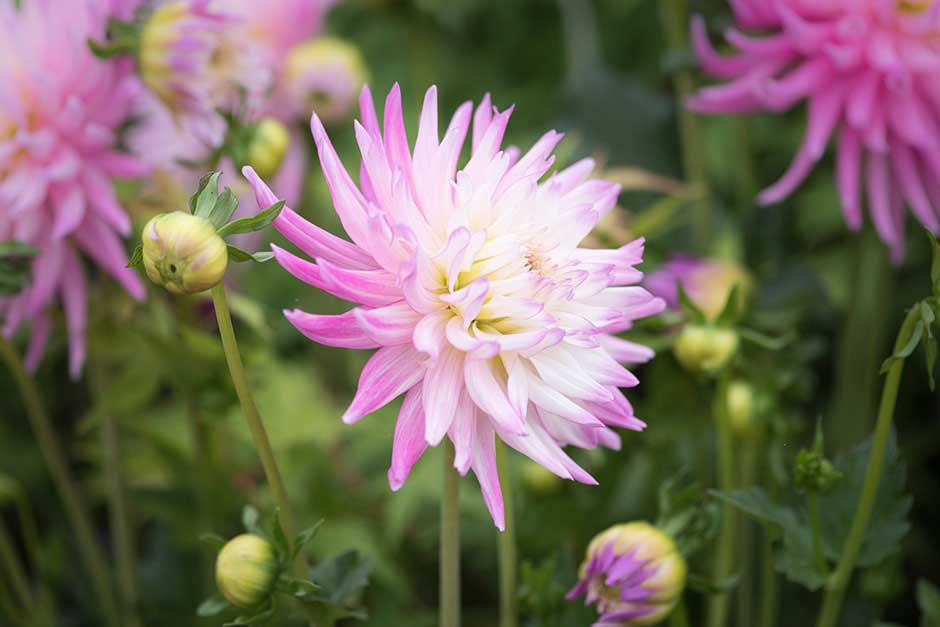Growing guide
How to grow dahlias
With showy blooms in a range of colours, sizes and shapes, dahlias light up sunny borders through summer and into late autumn. They suit most garden styles, from tropical to cottage borders, and smaller types can be grown in containers. As dahlia aren’t hardy, they need protection over winter.
Quick facts
- Moderately easy to grow
- Flowers from summer through autumn
- Like fertile, well-drained soil in sun
- Deadhead to boost flowering
- Not hardy, so protect from freezing conditions
- In most of the UK, store tubers indoors over winter
- Make new plants from cuttings, division or seed
All you need to know
What are dahlias?
Originally from Central America and Mexico, dahlias are tender perennials, which means they can live for many years, but do need protection from freezing temperatures. They grow from underground tubers, with the top growth dying back in winter and re-sprouting in spring. The
Tubers are swollen, usually underground, parts of a stem or root used to store food by the plant. They have buds that can produce new plants. Examples are tuberous begonia, cyclamen, dahlia and potato.
Dahlias are long-standing garden favourites for their bold, exotic flowers, produced over a long period. They are particularly valuable in late summer and autumn, blooming through to the first frosts. They have been widely bred to produce thousands of cultivars, with flowers in an array of styles, in colours from rich and vibrant to soft pastels, and in all sizes from 5cm (2in) across up to an impressive 30cm (1ft). The foliage is usually green, but there are darker colours too that provide a striking contrast to the flowers.
Dahlias are popular as cut flowers, and are also widely grown by enthusiasts for competitive shows.
Choosing dahlias
With such a range of flower colours, shapes and sizes, choosing dahlias is largely about personal taste. To browse photos and descriptions of many dahlia cultivars, go to RHS Find a Plant. You can also search by height, flower colour, RHS Award of Garden Merit and pollinator-friendliness, to help narrow down your choices.
Around 120 dahlia cultivars have an RHS Award of Garden Merit, which shows they performed well in RHS trials, so are reliable choices.
Dahlia flowers are often categorised by shape – waterlily, pompon, single, etc. In RHS Find a Plant the flower types are given after the plant name in abbreviated form, such as ‘C’ for cactus types, ‘Bal’ for ball, ‘Col’ for collarettes. Check out the National Dahlia Society’s useful guide to dahlia classifications.
When choosing dahlias, it’s also worth considering:
-
Different sizes suit different planting spots – shorter types (bedding dahlias), up to 60cm (2ft) tall, are best for containers and the front of borders. Most dahlias reach about 1.2m (4ft), for mid-border positions, and need staking for support. A few grow very tall, over 2m (6½ft)
-
As well as flower colour, consider leaf colour too – darker-leaved cultivars can provide useful visual contrast
-
Single flowers are best for pollinators – see our list of dahlias with an RHS Plants for Pollinators award
-
Big dinner-plate flowers look spectacular, but don’t blend well in borders
-
Growing from seed is a cost-effective way to create a large display
For a more inspiration, take a look at the dahlias growing in RHS Gardens in summer and autumn, including:
-
in the Exotic Garden and Mixed Borders at RHS Garden Wisley in Surrey
-
in the Sub-Tropicana Garden at RHS Harlow Carr in North Yorkshire
-
in the Hot Garden at RHS Rosemoor in Devon
-
in the Herbaceous Border at RHS Hyde Hall in Essex

Find out more from the National Dahlia Society
Buying dahlias
Dahlias are sold in four ways:
-
Potted plants in summer in full growth – and often in flower – from garden centres and online suppliers. Plants are ready for immediate planting and are the easiest option, providing an instant display
-
Dormant tubers and rooted cuttings from early to late spring.
Dormant tubers are widely available in garden centres and from online suppliers, while rootedDormancy refers to a period of inactivity in plants, during which they slow down or stop their growth, conserving energy and resources. This is a natural process that helps them survive harsh conditions, such as winter or drought. Dormancy in seeds is a mechanism that prevents them germinating until environmental conditions are favourable for growth.
A method of growing new plants from parts of an existing plant, such as sections of root, stem, leaf or bud. When prepared correctly and planted in the right conditions, they can produce roots and eventually become independent plants. There is a wide range of different methods for taking cuttings, depending on the plant and time of year.
-
Seeds – smaller bedding dahlias are available as seed, usually as a mix of colours or a single colour strain with some variation in hues. They are quick and easy to grow, and can start flowering in just a few months. They need to be sown and grown on indoors or in a heated greenhouse until large enough to transplant outside
RHS guide to buying healthy plants
RHS guide to bulbs and tubers
Where to plant
-
Dahlias need a warm, sheltered, sunny spot
-
They like rich, fertile soil that is moist, yet free-draining. They won’t thrive in very dry conditions and may rot in waterlogged soil
-
In lighter soils, dahlias are more likely to survive winter outdoors. They will grow in heavy soils, but these tend to be colder and soggier in winter, so the tender tubers should be dug up at the end of autumn and stored indoors over winter
-
Make sure there is plenty of space between plants – at least 60cm (2ft), and more for larger cultivars
-
The smaller bedding dahlias can also be grown in large containers
RHS guide to assessing your growing conditions
RHS guide to identifying your soil type
When to plant
As dahlias are tender, they won’t survive heavy frost, so must be kept indoors until temperatures are consistently above freezing.
-
Stored tubers are best planted in containers in spring and kept indoors or in a greenhouse, so they start into growth early. The plants can then be transplanted into their flowering site once there’s no danger of frost, usually in late May, or early to mid-June in colder regions. If you don’t have space to start them off indoors, you can plant directly outdoors in mid- to late April – see Planting dormant tubers outdoors below
-
Plants bought in containers in full growth in summer should be planted straight away
-
Seeds should be sown in early to mid-spring in a propagator – see Propagating, below
How to plant indoors
-
Dormant tubers and rooted cuttings should be planted in pots of multipurpose compost in spring
-
When planting dormant tubers, make sure they are the right way up. They usually look like a cluster of sausages, linked together at the top – this should be uppermost, positioned just below the surface of the compost. Shoots will appear from this point
-
Keep them frost-free, in good light and water regularly
How to plant outside
Before planting dahlias outside, acclimatise them to outdoor conditions – see our guide to hardening off.
Dahlias like fertile, free-draining soil, so prepare the planting site by digging in lots of organic matter, such as home-made compost or well-rotted manure – use one or two buckets per sq m/yd.
Also apply a general-purpose fertiliser to feed their vigorous growth, such as Growmore, following the instructions on the packet.
Planting is quick and easy:
-
Newly bought plants in containers and young plants grown from tubers – position these plants at the same level they were growing in their container. The top of the tubers, where the shoots appear, should be at the soil surface. Space plants about 60cm (2ft) apart
-
Rooted cuttings growing in containers – plant a few millimetres lower than they were in the container. Space plants 50–60cm (20in–2ft) apart
Water in well, then spread a thick layer of mulch over the soil to hold in moisture, leaving a gap around the base of the stems.
TOP TIP Why add mulch?
An organic mulch, such as home-made compost, is a great way to add nutrients and valuable micro-organisms to your soil. It also holds in moisture and deters weed germination.
New shoots are vulnerable to slugs and snails, so protect plants in their early stages of growth.
Smaller bedding dahlias can also be grown in summer container displays – see our guide to planting container displays.
RHS guide to planting potted perennials into borders
RHS video guide to planting up summer containers
Planting dormant tubers outdoors
If you don’t have space to start dormant tubers into growth in a greenhouse or indoors, you can plant them directly into their growing position in mid- to late April. Although frosts are still likely, the soil won’t freeze, so the tubers will be safe, and will start to make roots. By the time shoots come up in early June, all danger of damaging frost will be over. The plants will just be a little behind those started off earlier indoors.
-
Dig a deep hole to accommodate the long tubers
-
Position so the top of the tubers is just below soil level
-
Water generously, then apply a mulch to hold in moisture
Watering
Dahlias are thirsty plants and need additional watering in dry and hot weather. For tips on watering efficiently, see our guide below.
Plants in containers need regular watering throughout the growing season, as they dry out more quickly.
RHS guide to collecting and storing rainwater
RHS video guide to watering efficiently
Feeding
Dahlias are vigorous, fast-growing plants that perform best when given additional feeding:
-
Apply a granular general-purpose fertiliser at planting time
-
To boost flowering, apply a potassium-rich liquid fertiliser, such as tomato feed, fortnightly from early July to early September. Plants growing in containers are best fed weekly
RHS guide to looking after plants in containers
RHS guide to looking after plants in containers
RHS guide to feeding plantsRHS guide to feeding plants
Support
Dahlias in full flower can be top heavy, especially after rain, so all but the dwarf types need support:
-
Dahlias with large, multi-petalled flowers need stout posts for support, one per stem. Tie in the flower stems as they grow
-
With smaller-flowered dahlias, strong bamboo canes should be sufficient, either singly or four in a square around the clump, with twine looped around the outside
-
Dwarf bedding dahlias don’t need staking
RHS guide to staking perennialsRHS guide to staking perennials
Deadheading
To encourage dahlias to produce more flowers, deadhead regularly, ideally weekly. This ensures plants put all their energy into making flowers rather than seeds.To deadhead, simply remove each spent flower, cutting back to a leaf joint lower down the stem.
TOP TIP Deadheading dahlias
With dahlias, it can be tricky to tell a flower bud from a faded flower once the petals have dropped. Flower buds are usually rounded, while spent flowers are pointed.
Overwintering
Dahlia foliage will be killed off by frost in late autumn or winter. Once frosted, you can either leave plants in the ground or dig them up and store the tubers in a frost-free place over winter.If you’ve grown plants from seed, these will have developed tubers by the end of the season, which can also be left in situ or stored indoors. As seed-raised plants are genetically variable, only choose the best to keep.
Leaving tubers in the ground
-
You may choose to leave some or all of your dahlias in the ground over winter if you live in a milder region or have light, free-draining soil
-
This is by far the easiest option, but it is a risk. An unexpectedly harsh or very wet winter can lead to losses
-
Simply cut down the stems and cover the tops of the tubers (crowns) with 15cm (6in) of coarse mulch, such as bark chippings or garden compost, to protect them from frost
Storing tubers indoors
-
Dahlias are tender, so it’s safest to store the tubers indoors over winter, especially if you have heavy soil
-
Dig up the tubers before the first severe frost, taking care not to damage them, and shake off as much soil as possible
-
Cut the stems back to 5–15cm (2–6in) long and trim off any damaged tubers. Apart from that, leave them intact – if you want to split the clump to make more plants, do it in spring, as any wounds can offer an easy entry point for rot during storage
-
Place the tubers in shallow crates or open-topped boxes, covering with an insulating material such as dry potting compost or sand
-
Store in a dark, cool but frost-free place, such as a shed or garage. In very cold spells, put fleece or newspaper over them for added protection.
-
Check them occasionally, removing any showing signs of rot

RHS guide to overwintering tender plants
RHS guide to assessing your soil type
Thinning out stems
Dahlias are vigorous plants and the stems can become overcrowded. You may wish to thin them out in June/July to improve the overall display:
-
Aim to keep seven to ten sturdy stems per plant
-
Select spindly or overcrowded shoots that you want to remove – give them a sharp pull to break them off
-
With giant-flowered dahlias, limit the number of stems to three or five per plant to get fewer, but bigger blooms
Pinching out shoot tips
When the main stem gets to about 40cm (16in) tall, pinch out the tip, just above a pair of leaves. This will lead to branching at this point, resulting in a bushier plant.
If you’re growing for giant flowers or for cut flowers, nip out the smaller flower buds behind the central larger bud. This will give you larger, better quality flowers. But this isn’t necessary if you’re simply growing dahlias for border displays.
You can make new dahlia plants in spring by dividing clumps of tubers or taking cuttings. Dahlia seed mixes are also widely available and easy to grow if you have space indoors.
Dividing clumps of tubers
-
Start the dormant tubers into growth indoors in early spring (February) in a shallow tray of potting compost
-
When the shoots are about 2.5cm (1in) tall, lift the clump of tubers and divide it into several pieces, making sure each has both roots and shoots
-
Pot up each section into a separate container and grow on in a bright, frost-free place until late May/early June
-
Gradually acclimatise the plants to outdoor conditions by hardening off, then plant into their flowering positions – see Planting, above
If you’re planting dormant tubers straight into the ground in May, sometimes a large clump falls apart into separate pieces or can be helped with a snip from your secateurs. If there’s a green bud at the top of each piece of tuber, then you can simply plant them straight into the ground.
Taking cuttings
-
Pot up dormant tubers and start them into growth in warm conditions in late winter to early spring
-
Select healthy, vigorous shoots and take basal or softwood cuttings
-
As your new plants grow, move them into slightly larger pots
-
Keep them indoors until late May/early June, then gradually acclimatise them to outdoor conditions by hardening them off. Then plant into their flowering positions – see Planting, above
From seed
Bedding dahlias are available as packeted seed mixes and are easy to sow indoors in spring:
-
See our guide to sowing seeds indoors
-
When the seedlings are large enough to handle, prick out individually into modules or small pots
-
Apply liquid feed every two weeks
-
In late May/early June, gradually acclimatise them to outdoor conditions by hardening off, before planting into their flowering positions
Once they flower, you can select your favourite plants and save their tubers to grow next year.

RHS guide to taking softwood and basal cuttings
Dahlia plants can be affected by several pests, diseases and other problems:
-
Slugs particularly enjoy the young shoots, so put protection in place when planting out
-
Aphids (especially blackfly) can colonise succulent new growth
-
Powdery mildew can develop in dry conditions, so keep plants well watered
-
Capsid bugs, earwigs, caterpillars and red spider mites may also cause problems
-
Mosaic virus and tomato spotted wilt virus can occasionally lead to mottling and/or stunted growth
-
Leafy gall can cause dense clusters of distorted leafy shoots, often close to ground level
-
Plants can be damaged by manure contaminated by hormonal weedkillers. Weedkiller damage usually shows as distorted foliage. Plants will eventually grow through this
Poor flowering
-
To encourage flowering, feed fortnightly with a potassium-rich fertiliser, such as tomato feed
-
Ensure the plant is getting enough sun and isn’t overshadowed or crowded by other plants
-
Check the plant isn’t dry at the roots (poke a finger in below the surface)
-
Lots of leafy growth but few flowers can be due to overfeeding with nitrogen-rich fertiliser
Tubers rotting in storage
To ensure dahlia tubers store successfully over winter:
-
Take care to dry them off completely – turn them upside down for a few weeks, so all the moisture drains out of the hollow stems
-
Only store dried, healthy, undamaged tubers
-
Keep in a cool, frost-free place and check regularly for signs of rot
RHS guide to controlling pests and diseases without chemicals
RHS guide to avoiding pest and disease problems
Get more advice
If you’re a member of the RHS, you can use our online Gardening Advice Service, via MyRHS, for any gardening problems or queries.

Discover dahlias
Everything you need to know about choosing the right dahlia for you.
Get involved
The Royal Horticultural Society is the UK’s leading gardening charity. We aim to enrich everyone’s life through plants, and make the UK a greener and more beautiful place.